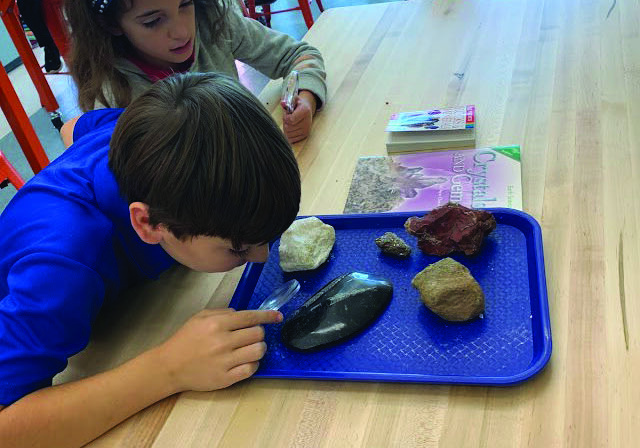Developing Scientific Thinkers in Lower School: Jessica Wawzyniecki

Renbrook first graders arrive brimming with curiosity, says Ms. W. Many have followed their interests on their own at home and already know a lot. “My goal,” she says, “is to take them deeper.”
First graders are learning the skills of being in a classroom more formally. Ms. W. trains their receptivity, openness, and focus as they study the planets. Some know the planets’ names and can tell you some facts about them. In STEAM, they explore questions: What are they made of? How do they move? How do astronomers learn more about them?
Ms. W. observes a big jump in maturity between first and second grade. Second graders are ready to collaborate, to work as a team. Negotiating to solve problems like setting up the hydroponic garden, they learn the value of disagreement in making a team stronger.
By third and fourth grades, students are asking deeper questions, probing based on what they know to find out more. They look closely at materials, for example, as engineers. Twill vs. terry: how do they differ and why? How does a process affect their qualities?
Third graders look at a phenomenon to understand cause and effect. How can we understand a hailstorm—how it forms, and what is happening within it? They use colored water to see what happens when hot and cold are mixed. They see that hot water (red) rises, while cold water (blue) sinks. They use materials in new, creative ways. During their Oregon Trail Project, they experiment with wagon coverings: what can you use to protect your precious possessions from the weather as you cross the Continental Divide? How do different materials behave under different conditions? How do science and engineering help us to understand the experiences of the Westward Movement?
Fourth graders work more independently; they can complete an experiment on their own. Then they proceed to design experiments by asking well-crafted questions. Ms. W.’s goal is to help fourth graders understand what real-life scientists do. Their experiments must address a question or a problem, not just be a trick or a game. When they study rocks, they go beyond classification. How are rocks used to solve problems in the real world?
As we continue our conversation, Spotty the snake makes his appearance, stirring in his glass-sided home. Ms. W. takes him out and affectionately displays him on her arm. Snakes love to hang, she explains. Spotty, a Kenyan Sand Boa, came to Renbrook as the pet of Sam Rouleau ’10 and was passed from teacher to teacher after Sam graduated. Ms. W., who had never touched a snake before she met Spotty, assures me that he is kind and gentle.
Ms. W.’s passion for science began in childhood; her parents were both scientists. Now her passion helps her students learn how to learn more about what they are interested in. “If one kid has an aha! moment, my day is made,” she says. In STEAM, she teaches that technology is not computers. It is any object, system, or process that is designed to solve a problem. One of her goals is “to get kids out of this world,” she says, gesturing to her laptop, “and into the actual world,” as adventurers.
Ms. W. sees a spiral, a developmental through line extending into Upper School, where topics students have begun exploring will be revisited on a more sophisticated level. Their enthusiasm is sustained as they sharpen their observational skills, reason more critically, learn to use data to question their assumptions, and test their understanding by communicating it to others. Jessica Wawzyniecki hopes that they will become inventive problem solvers who appreciate the world around them and are motivated to care for it.
A Note from Julie Schlossinger, Ed.D., Head of Lower School
Scientific thinking is not confined to STEAM, explains Julie Schlossinger, Head of Lower School. Mrs. Schlossinger describes the overall approach of Lower School teachers as guiding students from question to observation to discovery to developing their own ideas. She calls this constructivist learning.
The constructivist theory is based around the idea that learners are active participants in their learning journey; knowledge is constructed based on experiences, not passively received.
Lower School students form questions, make predictions, test their ideas, and document outcomes. This form of inquiry requires scientific thinking and involves collaboration.
Students in Lower School follow their interests in their non-fiction reading, building background knowledge as they develop the skills and habits of scholars. They take a scientific approach to reading comprehension, making predictions, gathering evidence, and writing their ideas, citing details they’ve gleaned. They take notes, expand their vocabularies, and post photos and videos on their homeroom apps. Math gives them opportunities to exercise problem solving skills and write about their mathematical reasoning. Social studies, too, is an experience in disciplined inquiry, analysis, and synthesis.